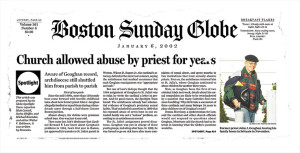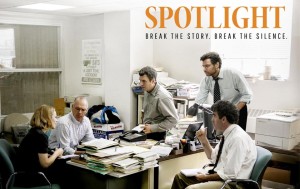Our lives begin to end the day we become silent about things that matter – Martin Luther King Jr

Courtesy : Hollywood Reporter
A newspaper deals in stories. Are there stories and matters that an entire community becomes silent about- newspaper included? Yes, there are. Spotlight, based on actual events, is one such story. The story envelops the very city and community that the newspaper marks out as its own turf by calling itself ‘ The Boston Globe.’ And it goes on to reveal how we inflict the conspiracy of silence on ourselves – as an organization and as a community.
The conspiracy of silence & cover-up
In the summer of 2001,a new editor at the Boston Globe leans on its four-member investigative report team, known as ‘Spotlight’ to dig deeper into a story written by an in-house columnist. A lawyer has charged that the Archbishop of Boston knew a priest was sexually abusing children but did nothing about it. As the Spotlight team starts investigating, they realize that this one case is just the tip of the iceberg. An expanding probe uncovers acts of wrong-doing and non-doing by institutions like the church and its clergy, the law and its lawyers, and the press and its reporters. All of them are wittingly or unwittingly involved in a conspiracy of silence and cover-up. Paedophile priests were sexually abusing children and no less than eighty-seven priests were at it in the city of Boston itself. The church had been merely shuffling the priests after they were exposed. These priests continued their abuse and the church in its privileged position as the upholder of the Faith continued its cover-up by settling out of court under a confidentialty agreement that swept everything under the carpet. After making the case water-tight with a thorough investigation, the Boston Globe publishes the sensational story in january 2002. As the story comes out, more victims call in and the full extent of the horror is revealed. Upto 1000 victims were abused in Boston itself and many had kept quiet because of shame and guilt.
How can society as a whole not know what was happening? Spotlight seeks to understand that.
Clinging to faith
As the movie unfolds, we find people and organizations clinging to faith. A community is powered by its faith in an incorruptible core. This core is the Church and its canon and its priests. No matter what goes wrong, people are loathe to cry out loud and speak truth to those in power. Those in power delude themselves into believing that their actions are in the larger interests of the community. They inoculate their own organizations against any chance of soul-searching by setting up a system of cover-ups. Journos, lawyers, the police, parishioners, everybody gets conned, co-opted or marginalized in the name of defending the faith. At it’s core, the movie is about the extent to which people will use power and subterfuge for clinging to their faith.
Relations between institutions
The new editor, Marty Baron is invited to meet the Archbishop, Cardinal Law as a goodwill gesture of cordial relations between the Catholic Church and the Press. The Cardinal is at that point unaware that Marty is prodding his team to investigate the case involving him. In a pivotal scene, the Cardinal says, ” The city flourishes when its great institutions work together.” Marty replies, ” Personally, I think that for a paper to best perform it’s function, it really needs to stand alone.” The Cardinal says, ” Of course”
This dialogue goes to the very heart of what makes a society, a community stay together in harmony. Should the institutions work together as the Cardinal alludes or is Marty right in asserting autonomy? As you look around, you will find a running debate on organizations working together and organizations working independently. Because there is so much talk on interdependence, we tend to overlook the value of independence.
In Spotlight, under Marty’s leadership, the Boston Globe decides to stand alone. But why?
Organizational Purpose
When Marty informs the publisher about his intention to investigate the Church and take matters to court, the publisher reminds him that 53% of Boston Globe subscribers are Catholic. Marty does not comment. The publisher does not press the matter and the movie implies that Marty continues to enjoy absolute editorial freedom.
If an organization depends on it’s customers, why does Marty risk losing more than half of the customers? This calls into question, the very purpose of a news-paper as an organization. It is evident that Marty is on a different tack. Is there something that helps him take a different perspective of the whole matter?
It takes an Outsider
Marty Baron is not from Boston. He is an outsider. His workforce initially holds it against him. In fact, there are many outsiders who end up helping the Spotlight team. This includes a sexual abuse survivor who has started a support group, a psycho-therapist who has researched paedophile priests for over 30 years and an Armenian lawyer who is determined to drag the church to court. These outsiders have been hounded and persecuted, but they haven’t given up. The lawyer in a conversation with a Spotlight reporter alludes to the interest in the case and mentions Marty’s Jewish roots and non-native origins. The lawyer says, ” It takes an outsider like me”
Yes, Marty is an outsider. That helps him steer clear of the embedded viewpoint. His Boston-based colleagues could not distance themselves to see what was happening. The church was a holy cow to them. Marty knows everybody on the team takes pride in the Boston Globe as the local paper. In highlighting the importance of the story, he says, ” This seems to me to be an essential story for a local paper.” It took an outsider to realize that.
The value of an outsider is a powerful running motif in unravelling the story. The Spotlight team does not do it alone. Outsiders have been valiantly fighting the battle for long. When the Spotlight team embraces the outsider perspective, it starts making the breakthroughs. The outsiders bring forward multiple stories for the team to piece together and uncover patterns.
Patterns of abuse and cover-up
The Spotlight team realize that the one case they started with is leading to a whole systemic cover-up. They realize how the Church shuffled the paedophile priests with the help of deceptive entries in official records. When the victims spoke up, lawyers were roped in to mediate a confidential, out-of-court settlement. Everything remained under wraps. The sordid deeds continued.
In doing their investigation, the Spotlight team uncovered a pattern of who the priests preyed on, how the court rehabilitated them, how the lawyers hushed things up. Every organization uncovers a pattern of things on the outside. If this discovery should have been made earlier, the organization has the opportunity to investigate the pattern of it’s own internal working and figure out why it did not discover things earlier.
From the point of view of a news-paper, the revealed pattern of the story itself should inspire a search for the pattern of our own coverage, our own historical response to similar stories. If we didn’t catch the significance of the story, what is it in our own set-up that contributed to the lapse? How did we as a newspaper fall silent? Surely, somebody understands the significance of the pattern. In Spotlight, that somebody is Marty Baron, the leader.
Leadership
When the spotlight team says that 13 priests were involved, they expect Marty to ask them to go ahead and publish the story. Marty asks them, ” What is the bigger story” In a brilliant display of quiet leadership, Marty reframes the entire case for the team. It is not the number of paedophile priests that is significant. The numbers won’t amount to much. If it can be proved that the Cardinal Law knew but did not act, that is the most powerful story. He reminds them that this is not about individual priests, but about the accountability of an institution. The Church is an institution that wields power. A story that examines the misuse of that power is the bigger story. As Marty says, “We are not going after the church, we are going after the system; the system from top to down.”
Later on, inspired by Marty’s guidance, the leader of the Spotlight team, Robby, holds back until he has done a comprehensive investigation even if the number of priests has shot up to 87 from 13. Robby’s team doesn’t want to wait, but Robby holds firm. The aim is to make a water-tight case not even the Church can fight against.
About the movie itself
Spotlight is a movie that doesn’t call attention to film-making as a craft. That is it’s supreme achievement. To not call attention is to do the bits so well they do not stand apart from the whole.
Understated, self-assured and courageous. A movie to be savoured.
